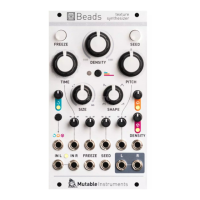J. Feedback, that is to say the amount of output signal
mixed with the input signal and fed back into the processing
chain. Each quality setting employs a different feedback am-
plitude limiting scheme typical of the medium it emulates–
from clean brickwall-limiting to grungy tape saturation.
K. Dry/wet balance.
L. Amount of
reverb. Modeled on the acoustics of
Thoreau’s cabin, or of a strip-mall spa.
The LED under each of these knobs indicates the amount of
modulation they receive from the assignable CV input (7).
Press the button [M] to select to which of these 3 destina-
tions the CV input (7) is assigned. Or hold this button and
turn the knobs [J], [K] and [L] to individually adjust the
amount of CV modulation.
8. Audio output. While the recording buffer can be mono
or stereo, Beads’ signal processing chain is always stereo.
If the R output is left unpatched, both L and R signals are
summed together and sent to the L output.
Hold the button [M] and press the SEED button [C] to enable
(or disable) the generation of a grain trigger signal on the R
output. A patch cable will have to be inserted in the R output
for this to work without affecting the L output!
If one of the grains’ parameters is randomized, or if
the grains are generated at a random rate, their pan
position will also be randomized.

